Relevance of Embodied Energy and Carbon Emissions on Assessing Cost Effectiveness in Building Renovation—Contribution from the Analysis of Case Studies in Six European Countries
Abstract
1. Introduction
The Significance of Considering Environmental Performance in Building Renovation
2. Methodology
2.1. Cost Optimal Methodology
2.2. Life Cycle Assessment
- PEbuilding is the primary energy of the building renovation;
- PEop energy use is the calculated primary energy for the operational energy use;
- PEBITS is the primary energy of the BITS;
- PEmaterials is the primary energy of all materials which were used in the building renovation.
3. Case Studies
4. Results
5. Conclusions
Author Contributions
Funding
Acknowledgments
Conflicts of Interest
References
- Gynther, K.; Lapillone, L.; Pollier, B. Energy Efficiency Trends and Policies in the Household and Tertiary Sectors Energy Efficiency Trends and Policies in the Household and Tertiary Sectors; An Analysis Based on the ODYSSEE and MURE Databases; Intelligent Energy Europe: Helsinki, Finland, 2015. [Google Scholar]
- Hsu, D.; Meng, T.; Han, A.; Suh, D. Further opportunities to reduce the energy use and greenhouse gas emissions of buildings. J. Plan. Educ. Res. 2017. [Google Scholar] [CrossRef]
- EU. Directive 2010/31/EU of the European Parliament and of the Council of 19 May 2010 on the energy performance of buildings (recast). Off. J. Eur. 2010, 18, 2010. [Google Scholar]
- Atanasiu, B.; Despret, C.; Economidou, M.; Maio, J.; Nolte, I.; Rapf, O. Europe’s Buildings under the Microscope; Buildings Performance Institute Europe: Brussels, Belgium, 2011. [Google Scholar]
- Artola, I.; Rademaekers, K.; Williams, R.; Yearwood, J. Boosting Building Renovation: What Potential and Value for Europe? Study for the ITRE Committee; Economic and Scientific Policy, IP/A/ITRE/2013-046, PE 587.326; European Parliament, Directorate General for Internal Policies, Policy Department A: Brussels, Belgium, October 2016. [Google Scholar]
- Ferreira, M.; Almeida, M.; Rodrigues, A. Cost-optimal energy efficiency levels are the first step in achieving cost effective renovation in residential buildings with a nearly-zero energy target. Energy Build. 2016, 133, 724–737. [Google Scholar] [CrossRef]
- Almeida, M.; Ferreira, M. IEA EBC Annex 56 vision for cost effective energy and carbon emissions optimization in building renovation. Energy Procedia 2015, 78, 2409–2414. [Google Scholar] [CrossRef]
- Almeida, M.; Ferreira, M. Cost effective energy and carbon emissions optimization in building renovation (Annex 56). Energy Build. 2017, 152, 718–738. [Google Scholar] [CrossRef]
- EC. Commission Delegated Regulation (EU) No 244/2012 of 16 January 2012 supplementing Directive 2010/31/EU of European Parliament and of the Council on the energy performance of buildings by establishing a comparative methodology framework for calculating cos. Off. J. Eur. 2012. [Google Scholar]
- Lützkendorf, T.; Foliente, G.; Balouktsi, M.; Wiberg, A.H. Net-zero buildings: Incorporating embodied impacts. Build. Res. Inf. 2015, 43, 62–81. [Google Scholar] [CrossRef]
- Ascione, F.; Cheche, N.; De Masi, R.F.; Minichiello, F.; Vanoli, G.P. Design the refurbishment of historic buildings with the cost-optimal methodology: The case study of a XV century Italian building. Energy Build. 2015, 99, 162–176. [Google Scholar] [CrossRef]
- Aelenei, L.; Paduos, S.; Petran, H.; Tarrés, J.; Ferreira, A.; Corrado, V.; Camelo, S.; Polychroni, E.; Sfakianaki, K.; Gonçalves, H.; et al. Implementing cost-optimal methodology in existing public buildings. Energy Procedia 2015, 78, 2022–2027. [Google Scholar] [CrossRef]
- Ferrari, S.; Beccali, M. Energy-environmental and cost assessment of a set of strategies for retrofitting a public building toward nearly zero-energy building target. Sustain. Cities Soc. 2017, 32, 226–234. [Google Scholar] [CrossRef]
- De Almeida, M.G.; Rodrigues, A.; Ferreira, M. Cost optimality and nzeb target in the renovation of portuguese building stock-rainha dona leonor neighborhood case study. In Proceedings of the SB13 Guimaraes-Contribution of Sustainable Building to Meet EU 20-20-20 Targetsin, Guimaraes, Portugal, 30 October–1 November 2013; pp. 35–42. [Google Scholar]
- Kalamees, T.; Pihelo, P.; Kuusk, K. Deep Energy Renovation of Old Concrete Apartment Building to nZEB by Using Wooden Modular Elements. Int. Holzbau Forum IHF 2017, 317–325. [Google Scholar]
- Van Oorschot, J.A.W.H.; Hofman, E.; Halman, J.I.M. Upscaling Large Scale Deep Renovation in the Dutch Residential Sector: A Case Study. Energy Procedia 2016, 96, 386–403. [Google Scholar] [CrossRef]
- Ferrara, M.; Fabrizio, E. Cost optimal nZEBs in future climate scenarios. Energy Procedia 2017, 122, 877–882. [Google Scholar] [CrossRef]
- Fava, J.A. Will the next 10 years be as productive in advancing life cycle approaches as the last 15 Years? Int. J. Life Cycle Assess 2006, 11, 6–8. [Google Scholar] [CrossRef]
- Bin, G.; Parker, P. Measuring buildings for sustainability: Comparing the initial and retrofit ecological footprint of a century home—The REEP House. Appl. Energy 2012, 93, 24–32. [Google Scholar] [CrossRef]
- Pombo, O.; Allacker, K.; Rivela, B.; Neila, J. Sustainability assessment of energy saving measures: A multi-criteria approach for residential buildings retrofitting—A case study of the Spanish housing stock. Energy Build. 2016, 116, 384–394. [Google Scholar] [CrossRef]
- Favi, C.; Meo, I.; Giuseppe, E.D.; Iannaccone, M.; D’Orazio, M.; Germani, M. Towards a probabilistic approach in LCA of building retrofit measures. Energy Procedia 2017, 134, 394–403. [Google Scholar] [CrossRef]
- Cabeza, L.F.; Rincón, L.; Vilariño, V.; Pérez, G.; Castell, A. Life cycle assessment (LCA) and life cycle energy analysis (LCEA) of buildings and the building sector: A review. Renew. Sustain. Energy Rev. 2014, 29, 394–416. [Google Scholar] [CrossRef]
- Ostermeyer, Y.; Wallbaum, H.; Reuter, F. Multidimensional Pareto optimization as an approach for site-specific building refurbishment solutions applicable for life cycle sustainability assessment. Int. J. Life Cycle Assess 2013, 18, 1762–1779. [Google Scholar] [CrossRef]
- De Angelis, E.; Dotelli, G.; Pittau, F.; La Torre, A.; Porcino, C.; Pansa, G.; Villa, N. LCA and LCC based energy optimization of building renovation strategies short summary. In Proceedings of the SB13 Graz-Sustainable Buildings Construction Products & Technologies, Graz, Austria, 25–28 September 2013. [Google Scholar]
- Tadeu, S.; Rodrigues, C.; Tadeu, A.; Freire, F.; Simões, N. Energy retrofit of historic buildings: Environmental assessment of cost-optimal solutions. J. Build. Eng. 2015, 4, 167–176. [Google Scholar] [CrossRef]
- Lasvaux, S.; Favre, D.; Périsset, B.; Mahroua, S.; Citherlet, S. Life Cycle Assessment for Cost-Effective Energy and Carbon Emissions Optimization in Building Renovation (Annex 56); International Energy Agency: Paris, France, 2017. [Google Scholar]
- Mateus, R.; Neiva, S.; Bragança, L.; Mendonça, P.; Macieira, M. Sustainability assessment of an innovative lightweight building technology for partition walls—Comparison with conventional technologies. Build. Environ. 2013, 67, 147–159. [Google Scholar] [CrossRef]
- BSI. BS EN 15978:2011 Sustainability of Construction Works. Assessment of Environmental Performance of Buildings. Calculation Method; The British Standards Institution: London, UK, 2011. [Google Scholar]
- EB, Eco-Bat 4.0-Eco Balance Assessment Tool. Available online: http://www.eco-bat.ch/index.php?option=com_content&view=article&id=64&Itemid=61&lang=en (accessed on 20 June 2018).
- ASCOT. ASCOT (Associated Costs) Software Developed by Cenergia Energy Consultants; Cenergia Energy Consultants: Herlev, Denmark, 2015. [Google Scholar]
- Thomsen, K.E.; Rose, J.; Mørck, O.; Jensen, S.Ø.; Østergaard, I.; Knudsen, H.N.; Bergsøe, N.C. Energy consumption and indoor climate in a residential building before and after comprehensive energy retrofitting. Energy Build. 2016, 123, 8–16. [Google Scholar] [CrossRef]
- Venus, D.; Höfler, K.; Thomsen, K.E.; Rose, J. Evaluation of the Impact and Relevance of Different Energy Related Renovation Measures on Selected Case Studies (Annex 56); International Energy Agency: Paris, France, 2015. [Google Scholar]
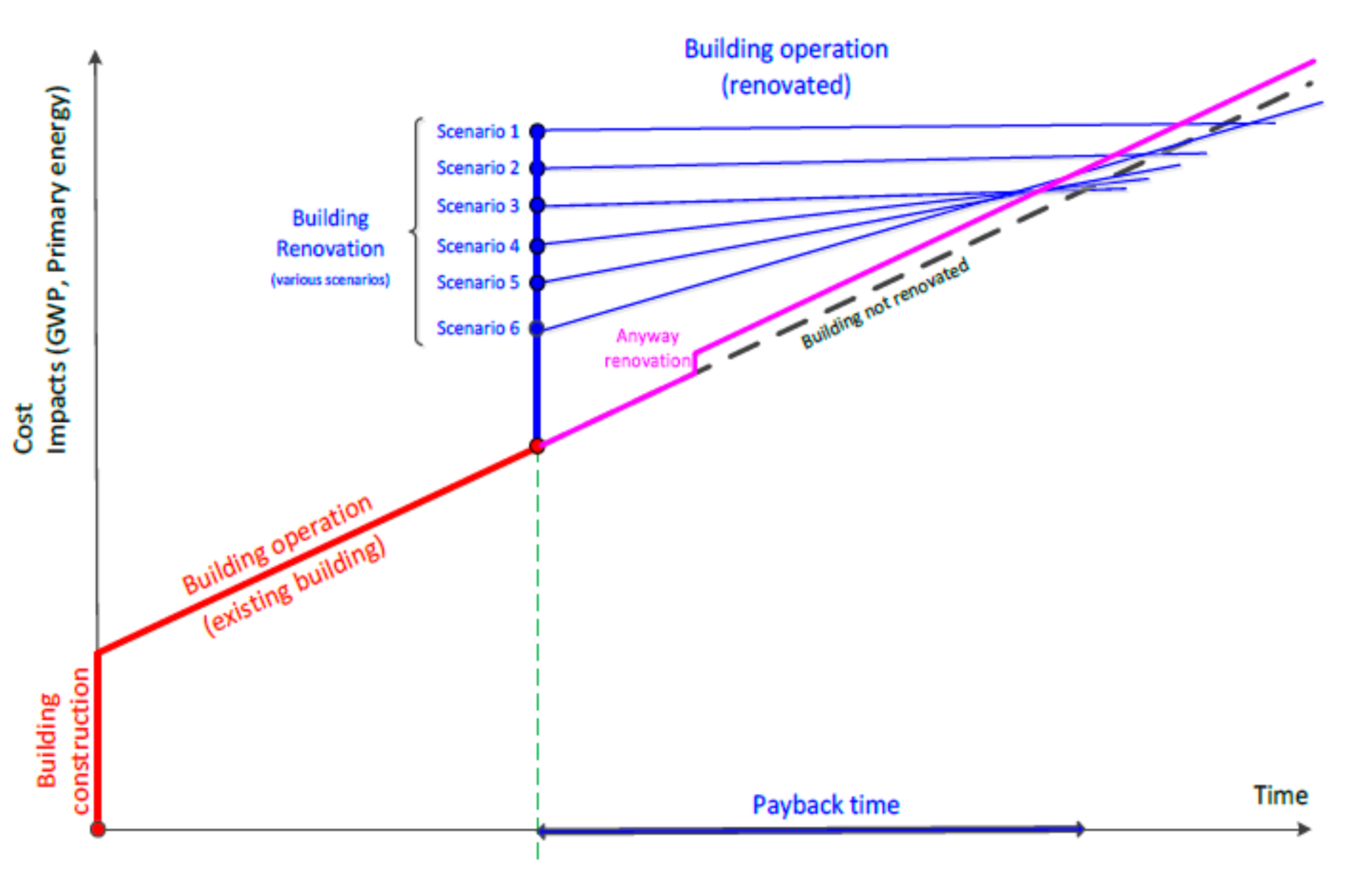
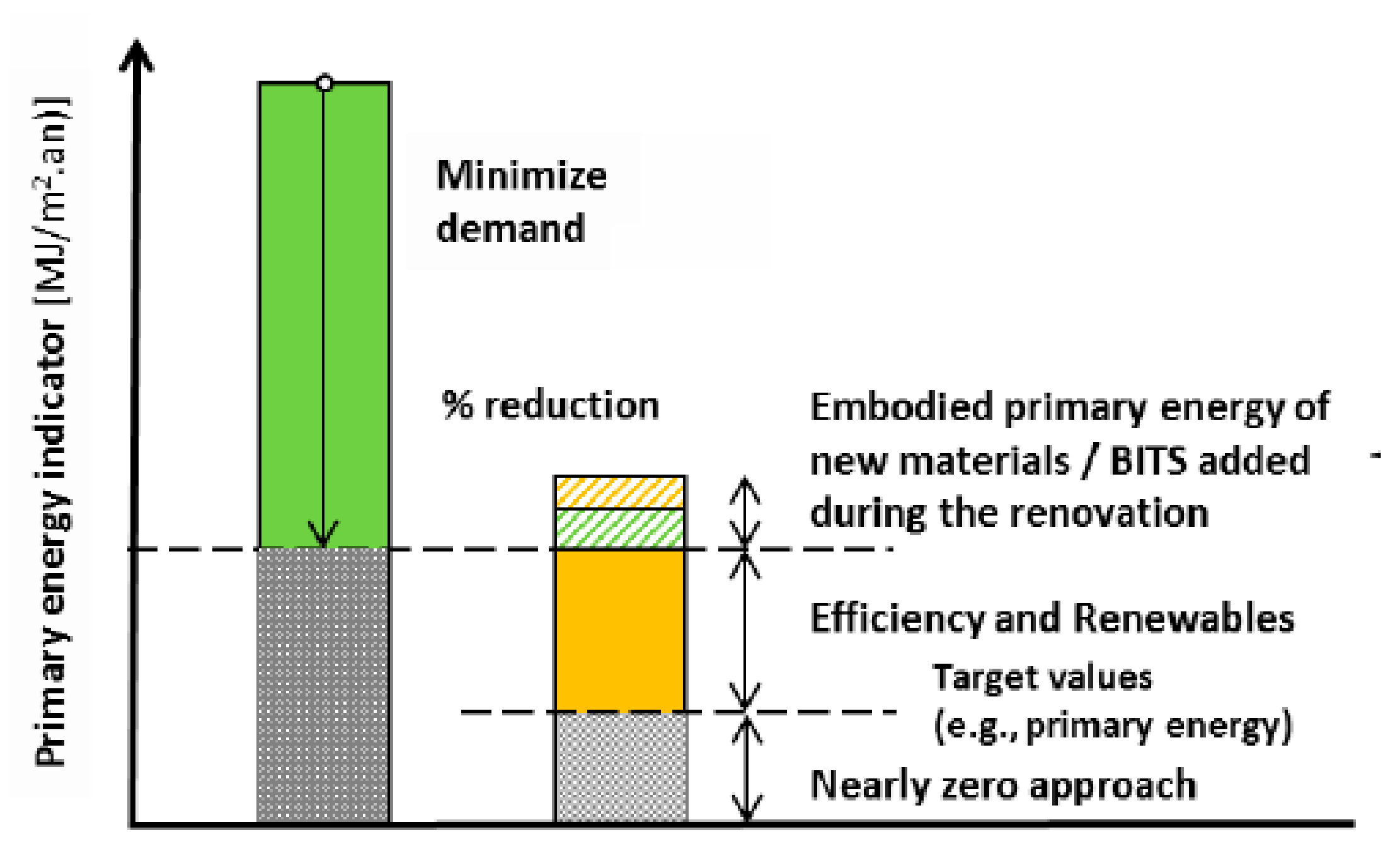
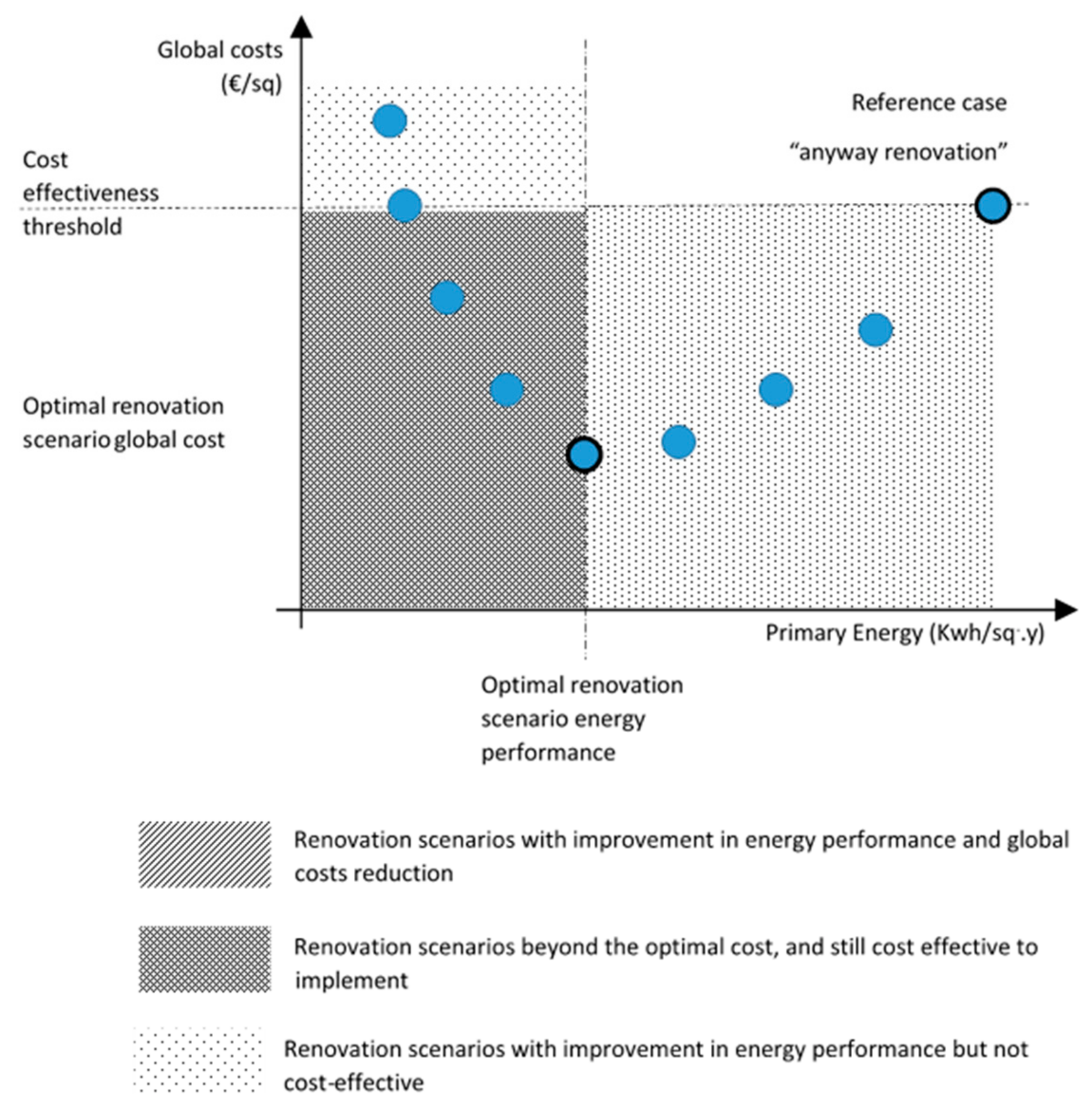
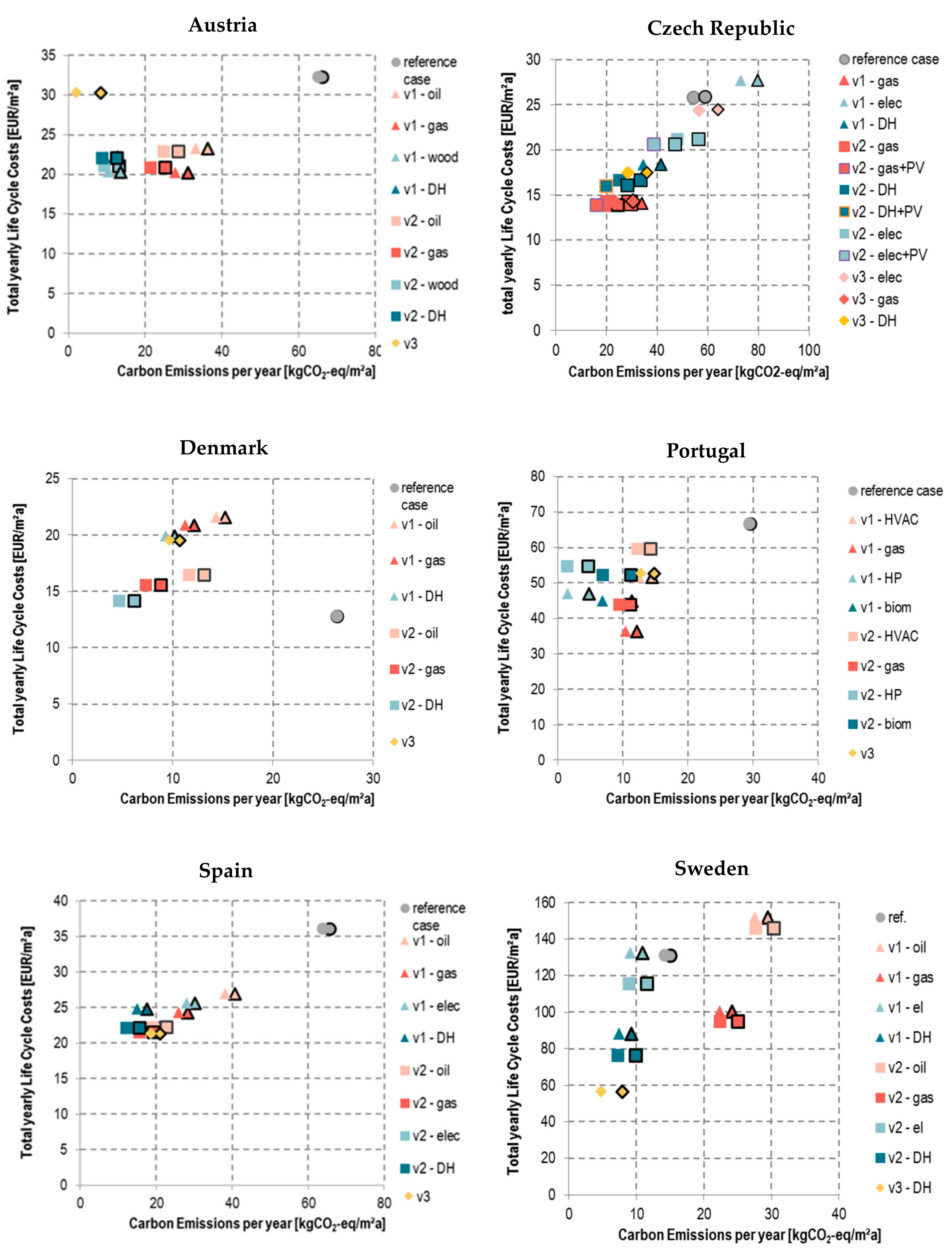
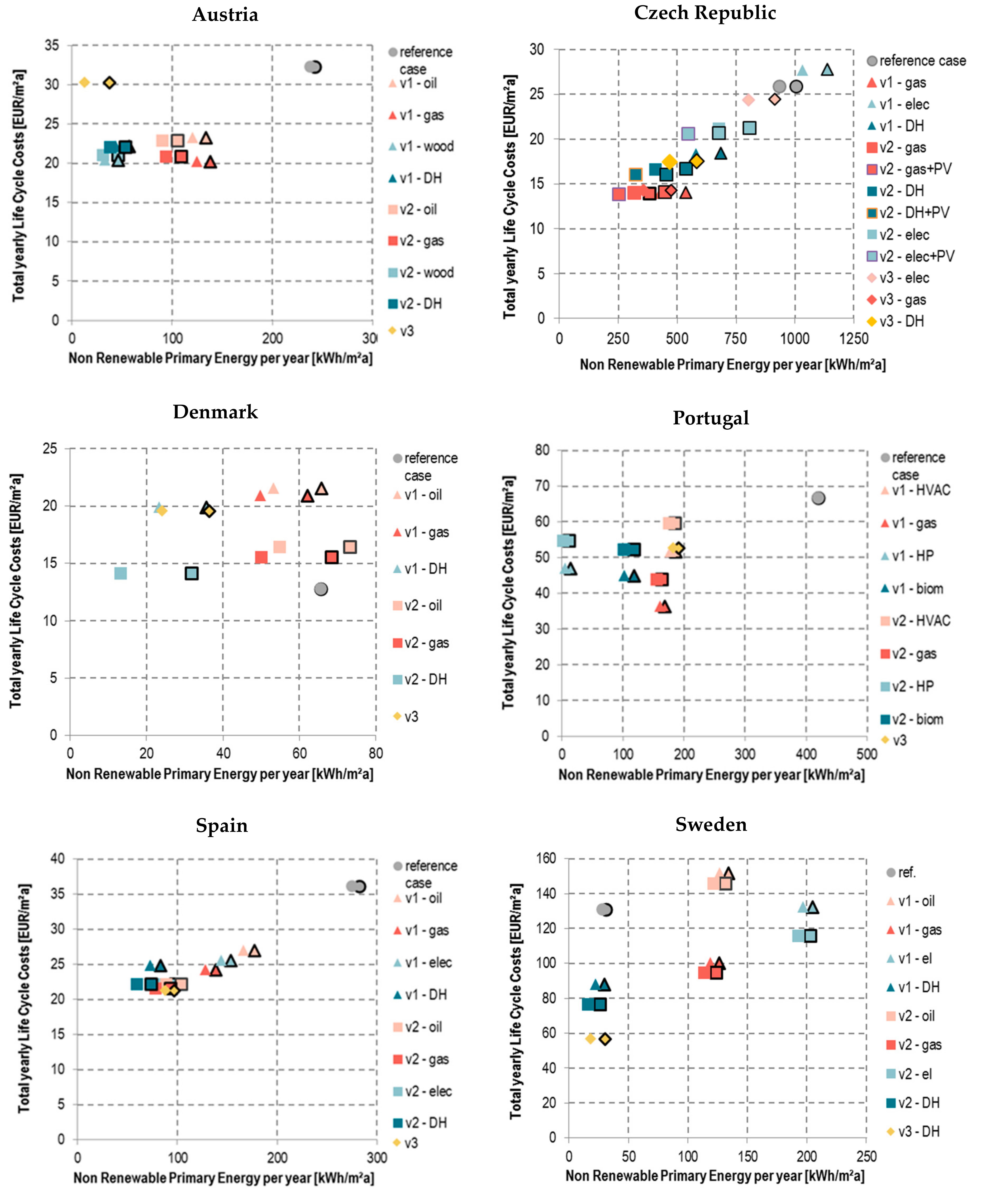
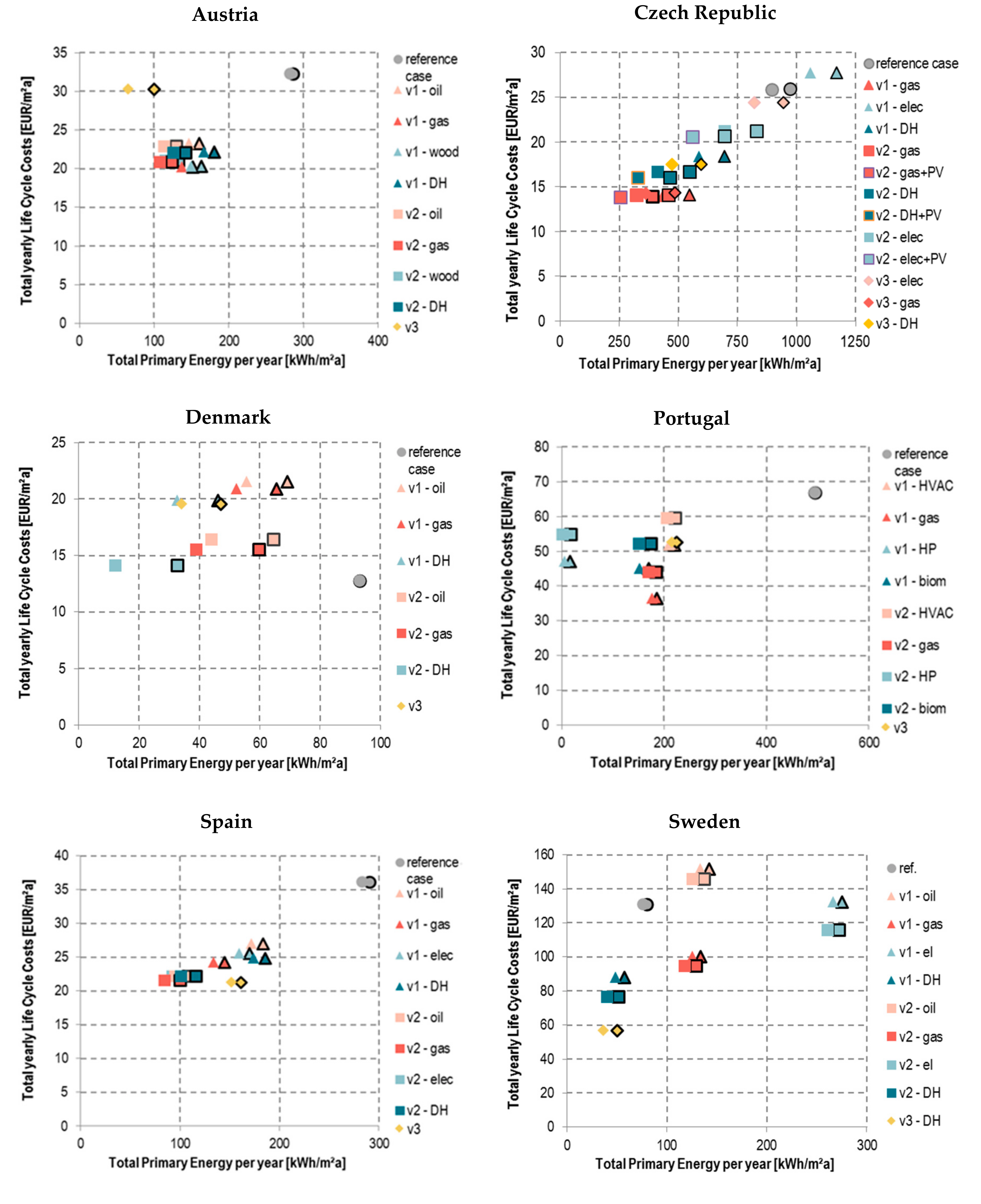
| Energy used by technical systems after renovation | Home appliances (Oven, refrigerator, TV…) | Not considered in the methodology |
| Common appliances (lifts, escalators…) | Optional in the methodology | |
| Heating | Mandatory in the methodology | |
| Domestic hot water | ||
| Air conditioning | ||
| Ventilation | ||
| Lighting | ||
| Auxiliary | ||
| Materials added and replaced for energy related renovation measures of building envelope | Materials for the building envelope (windows, thermal insulation…) | |
| Materials replaced to provide the same function (balcony, cladding, …) | ||
| Materials added and replaced for energy related renovation measures of the building integrated technical systems | Materials for energy production and distribution (Boiler, PV panels, bore-hole, pipes, radiators, …) |
| Country | KGC * | Before | After | Site | Building Type | Year of Construct | Year of Renovation | GHFA *1 (m2) |
|---|---|---|---|---|---|---|---|---|
| Austria | Dfb |  |  | Johann-Böhmstraße, Kapfenberg | Multi-family building | 1960–1961 | 2012–2014 | 2845 |
| Denmark | Cfb |  |  | Traneparken, Hvalsø | Multi-family Building | 1969 | 2011–2012 | 5293 |
| Sweden | Cfb |  |  | Backa röd, Gothenburg | Multi-family Building | 1971 | 2009 | 1357 |
| Czech Republic | Cfb |  |  | Kamínky 5, Brno | Elem. School | 1987 | 2009–2010 | 9909 |
| Portugal | Csb |  |  | Neighbourhood RDL, Porto | Two-family Building | 1953 | 2012 | 123 |
| Spain | Cfb |  |  | Lourdes Neighbourhood Tudela | Multi-family Building | 1970 | 2011 | 1474 |
| Case Study | Reference Case | Renovation Measures | ||
|---|---|---|---|---|
| V1 | V2 | V3—Implemented | ||
| Austria | Façade: Painting outside walls Windows: Painting and repair of wooden frame windows BITS: Central Heating and Domestic Hot Water production Energy Sources: Oil RES: None | Façade: 80 mm EPS Roof: 200 mm EPS Windows: Double glazed with external shading system BITS: Central heating and domestic hot water production Energy sources: Oil/natural gas/wood/DH with RES RES: None | Façade: 240 mm EPS Roof: 300 mm EPS Windows: Triple glazed with external shading system BITS: Central heating and domestic hot water production. Mechanical Ventilation with heat recovery (SFP = 1.62, Eff. = 65%) Energy Sources: Oil/natural gas/wood/DH with RES RES: None | Façade: Walls insulated with prefabricated wood modules (240 mm) Roof: 300 mm EPS Windows: Triple-glazed windows (with an external shading device) BITS: New central heating and domestic hot water production. New mechanical ventilation system with heat recovery (SFP = 1.62, Eff. = 65%) Energy Sources: District heating based on renewables RES: 144 m2 solar thermal system for heating and DHW production. 92 kWp PV system for electricity generation on-site |
| Denmark | Façade: Maintenance of the outer skin of external walls Roof: New Roofing Windows: Painting and repair of wooden windows BITS: Renewal of the heating and domestic hot water system Energy Sources: District heating based renewables with a share of 53% RES: none | Façade: 100 mm insulation Roof: 450 mm insulation Windows: Triple-glazed low-e windows BITS: Renewal of the heating and domestic hot water system. New mechanical ventilation system with heat recovery (SFP = 1.2, Eff. = 90%) Energy Sources: Oil/natural gas/DH with 53% RES RES: 33 kWp photovoltaic system for the electricity generation on-site | Façade: No intervention Roof: 450 mm insulation Windows: Triple-glazed low-e windows BITS: Renewal of the heating and domestic hot water system. New mechanical ventilation system with heat recovery (SFP = 1.2, Eff. = 90%) Energy Sources: Oil/natural gas/DH with 53% RES RES: 132 kWp photovoltaic system for the electricity generation on-site | Façade: 211 mm insulation Roof: 250 mm additional roof insulation Windows: Triple-glazed low-e windows BITS: Renewal of the heating and domestic hot water system. New mechanical ventilation system with heat recovery (SFP = 1.4, Eff. = 80%) Energy Sources: DH with 53% RES RES: 33 kWp photovoltaic system for the electricity generation on-site |
| Sweden (Sweden (cont.) | Façade: Maintenance of the façade BITS: New district heating substation, for heating and new recirculation for domestic hot water installed Energy Sources: District heating partly (81%) based on renewables RES: None | Façade: 100 mm insulation Roof: 100 mm insulation Windows: Triple glazed windows (U-value 1.7 W/m2K) BITS: Balanced mechanical ventilation system with heat recovery (Eff. = 50%) Energy Sources: Oil/natural gas/electricity/DH RES: No intervention | Façade: 195 mm insulation Roof: 300 mm insulation Windows: Triple glazed windows (U-value 0.9 W/m2K) BITS: New low-energy lighting Energy Sources: Oil/natural gas/electricity/DH RES: No intervention | Façade: 195 mm insulation Roof: 300 mm insulation Windows: Triple glazed windows (U-value 0.9 W/m2K) BITS: Balanced mechanical ventilation system with heat recovery (Eff. = 50%). New low-energy lighting Energy Sources: District heating partly (81%) based on renewables RES: No intervention |
| Czech Republic | Windows: Double and triple glazed. BITS: New mechanical ventilation system with heat recovery in the kitchen, storage rooms, toilets and showers New heating system including new storage tank for DHW. Energy Sources: District heating based on natural gas RES: None | Façade: 90 mm EPS Roof: 90 mm EPS Windows: Double and triple glazed. BITS: New mechanical ventilation system with heat recovery in the kitchen, storage rooms, toilets and showers New heating system including new storage tank for DHW. Energy Sources: District heating based on natural gas /electricity RES: Installation of a 66.42 kWp photovoltaic system for the electricity generation on-site | Façade: 290 mm EPS Roof: 300 mm EPS Windows: Triple glazed. BITS: New mechanical ventilation system with heat recovery in the kitchen, storage rooms, toilets and showers. New heating system including new storage tank for DHW. Energy Sources: District heating based on natural gas/natural gas/electricity RES: Installation of a 66.42 kWp photovoltaic system for the electricity generation on-site | Façade: 160 mm EPS Roof: 180 mm EPS Windows: Double and triple glazed. BITS: New mechanical ventilation system with heat recovery in the kitchen, storage rooms, toilets and showers New heating system including new storage tank for DHW. Energy Sources: District heating based on natural gas/natural gas/electricity RES: Installation of a 66.42 kWp photovoltaic system for the electricity generation on-site |
| Portugal (cont.) | Façade: Maintenance of outside walls Roof: Maintenance of the roof Windows: Maintenance of existing windows BITS: Renewal of the existing electrical heating and domestic hot water systems HVAC system for Cooling Energy sources: Electricity RES: None | Façade: 100 mm EPS Roof: 140 mm rock wool Windows: No intervention BITS: Replacement of the heating and domestic hot water system Energy Sources: Electricity/natural gas/biomass RES: 3.8 m2 solar thermal panels for DHW 3.7 kWp photovoltaic panels | Façade: 80 mm cork board insulation Roof: 80 mm cork board insulation Windows: Double Glazed BITS: Replacement of the heating and domestic hot water system Energy Sources: Electricity/natural gas/biomass RES: 3.8 m2 solar thermal panels for DHW 3.7 kWp photovoltaic panels | Façade: 60 mm EPS Roof: 50 mm XPS Windows: Double glazed BITS: Replacement of the heating and domestic hot water system Energy Sources: Electricity RES: 3.8 m2 solar thermal panels for DHW |
| Spain | Façade: Maintenance of existing façade Roof: Maintenance of existing roof Windows: Maintenance of single-glazed windows BITS: New central heating system for heating and domestic hot water production. Energy Sources: Oil RES: None | Façade: 40 mm EPS Roof: 40 mm XPS Windows: Double glazed BITS: Replacement of the heating and domestic hot water system Energy Sources: Oil, electricity/natural gas/DH with RES and gas (75%/25%) RES: None | Façade: 220 EPS Roof: 240 EPS Windows: Double glazed BITS: New central heating system for heating and domestic hot water production. New mechanical ventilation system with heat recovery which can be also used to pre-cool the air (SFP = 1.5, Eff. = 75%) Energy Sources: Oil, electricity/natural gas/DH with RES and gas RES: 26 m2 solar thermal system for DHW | Façade: 60 mm EPS Roof: 60 mm XPS Windows: Double glazed BITS: Renewal of the district heating system Energy Sources: DH with RES and gas (75%/25%) RES: 11 kWp photovoltaic system for the electricity generation on-site |
© 2018 by the authors. Licensee MDPI, Basel, Switzerland. This article is an open access article distributed under the terms and conditions of the Creative Commons Attribution (CC BY) license (http://creativecommons.org/licenses/by/4.0/).
Share and Cite
Almeida, M.; Ferreira, M.; Barbosa, R. Relevance of Embodied Energy and Carbon Emissions on Assessing Cost Effectiveness in Building Renovation—Contribution from the Analysis of Case Studies in Six European Countries. Buildings 2018, 8, 103. https://doi.org/10.3390/buildings8080103
Almeida M, Ferreira M, Barbosa R. Relevance of Embodied Energy and Carbon Emissions on Assessing Cost Effectiveness in Building Renovation—Contribution from the Analysis of Case Studies in Six European Countries. Buildings. 2018; 8(8):103. https://doi.org/10.3390/buildings8080103
Chicago/Turabian StyleAlmeida, Manuela, Marco Ferreira, and Ricardo Barbosa. 2018. "Relevance of Embodied Energy and Carbon Emissions on Assessing Cost Effectiveness in Building Renovation—Contribution from the Analysis of Case Studies in Six European Countries" Buildings 8, no. 8: 103. https://doi.org/10.3390/buildings8080103
APA StyleAlmeida, M., Ferreira, M., & Barbosa, R. (2018). Relevance of Embodied Energy and Carbon Emissions on Assessing Cost Effectiveness in Building Renovation—Contribution from the Analysis of Case Studies in Six European Countries. Buildings, 8(8), 103. https://doi.org/10.3390/buildings8080103







